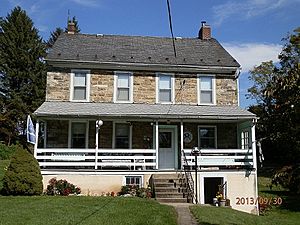John Rosbrugh facts for kids
Rev. John Rosbrugh (born around 1714, died 1777) was an important figure during the American Revolutionary War. He was a Presbyterian minister who graduated from the College of New Jersey (which is now Princeton University). In 1776, he helped organize a group of soldiers from Northampton County, Pennsylvania. He then became a chaplain for the army. A chaplain is like a minister or priest who serves in the military. Rev. Rosbrugh was sadly killed during the Battle of the Assunpink Creek, also known as the Second Battle of Trenton. He was the very first U.S. chaplain to die in battle.
Contents
Early Life of John Rosbrugh
John Rosbrugh was born around 1714 in Enniskillen, County Fermanagh, which is in Northern Ireland. He moved to the United States with his older brother, William. His family originally came from Craigie, County Ayrshire, Scotland. His ancestors had moved to Ireland during a time called the Ulster Plantation. In 1733, a sad event happened: his young wife Sarah died while giving birth, and their only child also passed away. Even though he worked as a tradesman, he was educated enough to prepare himself for college.
Becoming a Minister
John Rosbrugh attended the College of New Jersey and graduated in 1761. He was given permission to preach in August 1763. In October 1764, he was sent to serve several church groups in western New Jersey, including Greenwich, Oxford, and Mansfield Woodhouse. By December 1764, he officially became a Presbyterian minister.
In 1765, he was asked to serve more churches in nearby Upper and Lower Hardwick, New Jersey. In 1766, Rev. Rosbrugh married Jane Ralston. Her father, James Ralston, lived in a place called 'the Irish Settlement' in East Allen Township, Northampton County, Pennsylvania. In 1769, Rev. Rosbrugh was asked to become the permanent minister at the church in Allen Township, which was his wife's home congregation. He led this church for seven years.
Serving in the Revolutionary War
When the American Revolutionary War began, news often reached people through their churches. This was a main way for people to get information back then. On December 10, 1776, General George Washington asked for help from the Pennsylvania militia. He wrote to the colonels of the Northampton and Bucks counties militias, asking them to join him quickly.
Rev. Rosbrugh read General Washington's letter to his church members. The men of his congregation decided to form a militia company. They agreed to go to war only if Rev. Rosbrugh would lead them. He had planned to go as their chaplain, but he agreed to lead them. John Rosbrugh put his musket over his shoulder and led his company to join General Washington and the Continental Army in Philadelphia.
Chaplain for the Army
While in Philadelphia, Rev. Rosbrugh was officially made a Chaplain. A chaplain at that time held the rank of major. Captain John Hays then took over as the company commander. British soldiers especially disliked Presbyterian ministers, so if they were captured, they were treated very badly.
Rev. Rosbrugh’s company joined the rest of the Northampton county militia in camp. Rosbrugh also met with his brother-in-law, John Ralston, who was a member of the Second Continental Congress. Their battalion was under the command of General Israel Putnam. They were supposed to cross the Delaware River on December 25th to help Washington’s surprise attack on Trenton. However, General Putnam decided not to cross because of bad weather. So, Rev. Rosbrugh’s battalion stayed in Philadelphia.
After General Washington crossed back to Pennsylvania, he decided to attack Trenton a second time. This time, the 3rd Northampton militia was included. This battle is known as the Second Battle of Trenton or the Battle of Assunpink Creek.
Death in Battle
On the afternoon of January 2, 1777, the American soldiers were getting ready for the upcoming battle. Rev. John Rosbrugh was eating at a public house (like an inn) when someone shouted that Hessians were coming. Hessians were German soldiers hired by the British.
When he went outside, he found his horse had been taken. He tried to get back to the American lines, which were on the other side of Assunpink Creek. But he was suddenly faced by a group of Hessians led by a British officer. He surrendered, but they recognized him as a Presbyterian minister. The Hessians killed him.
Captain Hays, his company commander, found Rev. Rosbrugh's body and quickly buried him where he fell. The next morning, Rev. George Duffield, another Presbyterian chaplain, moved Rev. Rosbrugh's body to the nearby graveyard of the First Presbyterian Church of Trenton. It is believed he still rests there today. His wife, Jane (who was born Ralston), lived for 32 years after him. She was buried in the East Allen Township cemetery, and her tombstone says her husband John is buried beside her.
Rev. Rosbrugh's Family
Around 1766, John Rosbrugh married Jane Ralston (1739–1809). She was the daughter of James Ralston from the Irish Settlement in Allen Township, Pennsylvania. John and Jane had five children:
- James Rosbrugh (1767–1850) – He became a judge and a New York State legislator. He was also a Captain in the militia during the War of 1812. He lived in Groveland, New York.
- Letitia Rosbrugh (1769–1859) – She married Samuel Ralston and they lived in Allen Township, Pennsylvania.
- Mary Rosbrugh – She married her cousin, Robert Ralston, who was a member of the Continental Congress.
- Sarah Rosbrugh – She never married and moved to Western New York. She died at seventy-six years old.
- John Rosbrugh (born around 1776, died after 1880) – He never married and stayed in Allen Township, Pennsylvania.


